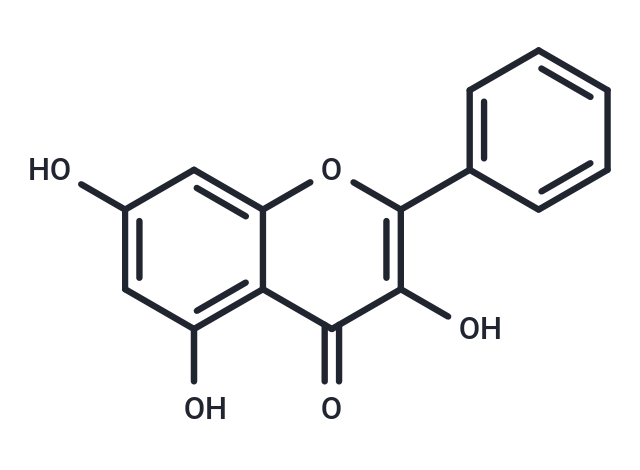Shopping Cart
- Remove All
 Your shopping cart is currently empty
Your shopping cart is currently empty
Galangin (Norizalpinin) is an agonist/antagonist of the arylhydrocarbon receptor, and also shows inhibition of CYP1A1 activity.

| Pack Size | Price | Availability | Quantity |
|---|---|---|---|
| 5 mg | $30 | In Stock | |
| 10 mg | $47 | In Stock | |
| 25 mg | $77 | In Stock | |
| 50 mg | $123 | In Stock | |
| 100 mg | $217 | In Stock | |
| 500 mg | $543 | In Stock | |
| 1 mL x 10 mM (in DMSO) | $52 | In Stock |
| Description | Galangin (Norizalpinin) is an agonist/antagonist of the arylhydrocarbon receptor, and also shows inhibition of CYP1A1 activity. |
| In vitro | Through thin-layer chromatography, it has been demonstrated that Galangin impedes the catabolic decomposition of DMBA in a dose-dependent fashion and obstructs the generation of DMBA-DNA adducts, thereby averting DMBA-related suppression of cell proliferation. Additionally, Galangin robustly curtails CYP1A1 enzyme activity in a dose-responsive manner within both intact cells and DMBA-exposed cell-derived microsomes, as ascertained through ethoxyresorufin-O-deethylase activity assays. The inhibition of CYP1A1 by Galangin occurs through a noncompetitive mechanism, as evidenced by double-reciprocal plot analysis. Moreover, Galangin elevates CYP1A1 mRNA levels, suggesting potential aryl hydrocarbon receptor agonism, yet it counteracts the DMBA or TCDD-triggered upregulation of CYP1A1 mRNA and promoter-driven transcription[1]. Furthermore, Galangin administration hampers cell proliferation while propelling autophagy at 130 μM and apoptosis at 370 μM. Specifically, in HepG2 cells, Galangin induces autophagosome accumulation, enhances microtubule-associated protein light chain 3 levels, and augments the proportion of vacuolated cells, alongside a surge in p53 expression. The Galangin-induced autophagic response is mitigated by p53 inhibition in HepG2 cells, while p53 overexpression in Hep3B cells normalizes the elevated vacuole presence[2]. |
| Cell Research | Cells (5.0×103) are seeded and treated with different concentrations of galangin for different periods of time in 96-well plates. The number of viable cells in each well is determined by adding 10 μL of 5 mg/mL MTT solution. Following the 4 hour incubation at 37°C, the cells are dissolved in a 100 μL solution containing 20% SDS and 50% dimethy formamide. The optical densities are quantified at a test wavelength of 570 nm with a reference wavelength of 630 nm using a Varioskan Flash Reader spectrophotometer. |
| Synonyms | Norizalpinin, 3,5,7-Trihydroxyflavone |
| Molecular Weight | 270.24 |
| Formula | C15H10O5 |
| Cas No. | 548-83-4 |
| Smiles | Oc1cc(O)c2c(c1)oc(-c1ccccc1)c(O)c2=O |
| Relative Density. | 1.579 g/cm3 |
| Color | Yellow |
| Appearance | Solid |
| Storage | Powder: -20°C for 3 years | In solvent: -80°C for 1 year | Shipping with blue ice/Shipping at ambient temperature. | |||||||||||||||||||||||||||||||||||
| Solubility Information | Chloroform, Dichloromethane, Ethyl Acetate, Acetone: Soluble DMSO: 237 mg/mL (877 mM), Sonication is recommended. | |||||||||||||||||||||||||||||||||||
Solution Preparation Table | ||||||||||||||||||||||||||||||||||||
DMSO
| ||||||||||||||||||||||||||||||||||||

Copyright © 2015-2025 TargetMol Chemicals Inc. All Rights Reserved.